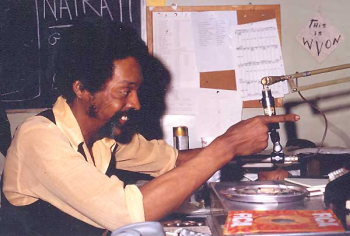Primary Sources, Primary Sounds: The Radio Preservation Task Force of the Library of Congress Josh Shepperd / Catholic University

A historical marvel of nation-building, serialization, and aesthetic innovation, radio has also been utilized for multiple purposes beyond entertainment: from education, to a technology of opinion-formation, to a medium for political problem-solving. Much of the early history of the ether consists of distance learning broadcasts, public forums, and civic debates, and in addition to local theatrical and drive time programming the task force is concerned with making these important historical records accessible for the first time. To frame the project in historiographical terms, the RPTF is approaching radio history as a study of what the Birmingham school might call the genealogy of how strategies for circulation of discursive codes, as representations, became central to an expanded concept of the public sphere that included popular culture. If we accept the historiographical argument that content representations are also implementations of discursive, political, and industrial strategies, then radio might be viewed as a medium in which institutional and intellectual projects endeavored to communicate with and persuade community members about a specific perspective or initiative. In this way, radio history has the capacity to reveal the development and dissemination of cultural aspirations and viewpoints, and its consequent archive can be understood as a series of concurrent media advocacies that sought to define conditions of social attunement.
Beginning with these guiding historiographical tenets, many dominant debates that we associate with the academic study of media theory, audiences, and media industries suddenly propel radio into a central position of interest. For example Paul Lazarsfeld and Theodor Adorno’s argument over how quantitative survey research of educational broadcasting might promote progressive goals is an ongoing debate between qualitative humanists and social scientists. Wilbur Schramm’s post-war construction of communication departments provided a stable home for educational broadcasting, early public policy analysis, and anti-fascist projects UNESCO and Voice of America. CBS president and Lazarsfeld protégé Frank Stanton built a huge production culture of writers, producers, and developers who defined radio as a civic medium for commercial practice. And in many ways, this paradoxical concept, commercialism as civic practice, is for better or worse the major successful media advocacy of the 20th century. Our memory of media history sometimes seems entirely inseparable from this logic of consumerism, to the extent that the discipline is overwhelmingly focused on affirmative or resistant reactions to what amounts to a very small sampling of the experience of media, as it has been facilitated by national and transnational entertainment.

The perceived historical record is primed to grow significantly over the next several years thanks to our mandate from the National Recording Preservation Board, NRPB Chair Sam Brylawski, and our large consortium of media researchers headed by Project Director and eminent historian Christopher Sterling. Digitization, education, and distribution initiatives will increase archival representation and access, and in truth we still don’t know what or how much we’ll turn up. But we do know that as the golden age of library science continues to streamline methods of preservation, that (without exaggeration) tens of thousands of historical statements will be introduced into circulation over the next 3-5 years.
As I write, the RPTF1) is conducting a second round of aggregation of participating archives. Our current participant consortium is impressive – besides the Library of Congress we will be working with the National Archives of the U.S. and Canada, Our Coordinating Archive – The Library of American Broadcasting, The Paley Center, Peabody Awards, Stanford Archives of Recording Sound, Syracuse Belfer Audio Archive, Newseum, and the Wisconsin Center for Film and Theater Research, among many, many others.2 But we believe that many of our most important finds will turn up in personal collections, radio station attics, library basements, and historical societies. Over the next 3-6 months the RPTF will be working to locate and nearly double archive participation to include these equally important repositories, culminating in a conference to discuss preliminary findings at the Library of Congress.

Image Credits:
1. RPTF Logo, courtesy of the author; designed by artist Daniel Murphy (University of Wisconsin-Milwaukee).
2. LOC Reading Room
3. DJ Herb Kent
4. RPTF Icon
- RPTF logo designed by artist Daniel Murphy (University of Wisconsin-Milwaukee [↩]
- http://www.loc.gov/programs/national-recording-preservation-plan/about-this-program/radio-preservation-task-force/affiliate-archives/ [↩]
Pingback: Sound History is Cultural History: Primary Documents and Progressive Radio Research - Radio Survivor
Pingback: Radio Preservation Task Force Conference: Sound History and the Logistics of Social Recognition | Sounding Out!